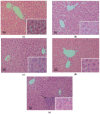The Effects of Syzygium samarangense, Passiflora edulis and Solanum muricatum on Alcohol-Induced Liver Injury
- PMID: 27681723
- PMCID: PMC5085649
- DOI: 10.3390/ijms17101616
The Effects of Syzygium samarangense, Passiflora edulis and Solanum muricatum on Alcohol-Induced Liver Injury
Abstract
Previous studies have shown that fruits have different effects on alcohol metabolism and alcohol-induced liver injury. The present work selected three fruits and aimed at studying the effects of Syzygium samarangense, Passiflora edulis and Solanum muricatum on alcohol-induced liver injury in mice. The animals were treated daily with alcohol and fruit juices for fifteen days. Chronic treatment with alcohol increased the levels of aspartate transaminase (AST), alanine transaminase (ALT), total bilirubin (TBIL), triglyceride (TG), malondialdehyde (MDA), and decreased total protein (TP). Histopathological evaluation also showed that ethanol induced extensive fat droplets in hepatocyte cytoplasm. Syzygium samarangense and Passiflora edulis normalized various biochemical parameters. Solanum muricatum increased the level of ALT and induced infiltration of inflammatory cells in the liver. These results strongly suggest that treatment with Syzygium samarangense and Passiflora edulis could protect liver from the injury of alcohol, while Solanum muricatum could aggravate the damage.
Keywords: Passiflora edulis; Solanum muricatum; Syzygium samarangense; alcohol; liver injury.
Conflict of interest statement
The authors declare no conflict of interest.
Figures








Similar articles
-
Effects of 20 Selected Fruits on Ethanol Metabolism: Potential Health Benefits and Harmful Impacts.Int J Environ Res Public Health. 2016 Apr 1;13(4):399. doi: 10.3390/ijerph13040399. Int J Environ Res Public Health. 2016. PMID: 27043608 Free PMC article.
-
Solanum muricatum Ait. inhibits inflammation and cancer by modulating the immune system.J Cancer Res Ther. 2014 Jul-Sep;10(3):623-30. doi: 10.4103/0973-1482.138198. J Cancer Res Ther. 2014. PMID: 25313750
-
Wax apple (Syzygium samarangense) fruit extract ameliorates endothelial dysfunction and liver damage in high cholesterol diet-fed rats.J Tradit Complement Med. 2022 Aug 14;12(6):584-593. doi: 10.1016/j.jtcme.2022.08.002. eCollection 2022 Nov. J Tradit Complement Med. 2022. PMID: 36325247 Free PMC article.
-
Sugars, ascorbic acid, total phenolic content and total antioxidant activity in passion fruit (Passiflora) cultivars.J Sci Food Agric. 2013 Mar 30;93(5):1198-205. doi: 10.1002/jsfa.5876. Epub 2012 Oct 2. J Sci Food Agric. 2013. PMID: 23027609
-
A Review of the Pharmacological Effects of Solanum muricatum Fruit (Pepino Melon).Foods. 2024 Aug 29;13(17):2740. doi: 10.3390/foods13172740. Foods. 2024. PMID: 39272505 Free PMC article. Review.
Cited by
-
Health Functions and Related Molecular Mechanisms of Tea Components: An Update Review.Int J Mol Sci. 2019 Dec 8;20(24):6196. doi: 10.3390/ijms20246196. Int J Mol Sci. 2019. PMID: 31817990 Free PMC article. Review.
-
Phytocompounds from Amazonian Plant Species against Acute Kidney Injury: Potential Nephroprotective Effects.Molecules. 2023 Sep 2;28(17):6411. doi: 10.3390/molecules28176411. Molecules. 2023. PMID: 37687240 Free PMC article. Review.
-
Passiflora edulis: An Insight Into Current Researches on Phytochemistry and Pharmacology.Front Pharmacol. 2020 May 20;11:617. doi: 10.3389/fphar.2020.00617. eCollection 2020. Front Pharmacol. 2020. PMID: 32508631 Free PMC article. Review.
-
The In Vivo Antioxidant and Hepatoprotective Actions of Selected Chinese Teas.Foods. 2020 Mar 2;9(3):262. doi: 10.3390/foods9030262. Foods. 2020. PMID: 32121649 Free PMC article.
-
Constituent Characteristics and Functional Properties of Passion Fruit Seed Extract.Life (Basel). 2021 Dec 27;12(1):38. doi: 10.3390/life12010038. Life (Basel). 2021. PMID: 35054431 Free PMC article. Review.
References
LinkOut - more resources
Full Text Sources
Other Literature Sources
Miscellaneous

